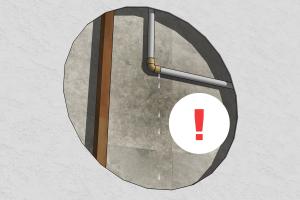Ultimate Guide to Detecting Water Leaks in Walls: Signs, Methods & Solutions

-
Quick Links:
- Introduction
- Understanding Water Leaks
- Signs of Water Leaks in Walls
- Tools and Methods to Detect Water Leaks
- Step-by-Step Detection Guide
- Case Studies
- Expert Insights
- Preventing Water Leaks
- FAQs
Introduction
Water leaks can be a homeowner's worst nightmare. They not only lead to extensive property damage but can also create a breeding ground for mold and mildew, which poses health risks. This comprehensive guide will equip you with the knowledge to identify and address water leaks in your walls effectively.Understanding Water Leaks
Water leaks can originate from various sources, including: - **Plumbing Issues**: Broken pipes, faulty fixtures, or corroded pipes can lead to leaks. - **Roof Leaks**: Water can seep through the roof, especially in older homes. - **Weather Conditions**: Heavy rain or snow can cause water to penetrate walls. Understanding the source of water leaks is crucial for effective detection and repair.Signs of Water Leaks in Walls
Detecting water leaks early can save you thousands in repairs. Here are some common signs to look out for: 1. **Water Stains**: Dark spots or discoloration on walls or ceilings. 2. **Peeling Paint or Wallpaper**: Bubbling or peeling indicates moisture trapped behind the surface. 3. **Mold Growth**: Black or green patches emerging in damp areas. 4. **Unusual Odors**: A musty smell often indicates mold or mildew growth. 5. **Increased Water Bill**: A sudden spike in your water bill without increased usage.Tools and Methods to Detect Water Leaks
Detecting leaks requires a combination of tools and methods. Here are some effective techniques: - **Moisture Meters**: These devices measure the moisture content in materials. - **Infrared Cameras**: They detect temperature differences that indicate moisture presence. - **Acoustic Listening Devices**: These tools detect the sound of water escaping from pipes.Step-by-Step Detection Guide
1. **Visual Inspection**: Start with a thorough examination of your walls, ceilings, and floors. 2. **Use a Moisture Meter**: Test suspicious areas for moisture levels. 3. **Check for Temperature Changes**: Use an infrared camera to identify cold spots. 4. **Listen for Sounds**: Use acoustic devices to pinpoint the source of the leak. 5. **Conduct Water Pressure Tests**: Check plumbing systems for pressure drops.Case Studies
**Case Study 1: Aging Pipes in a Residential Home** A family noticed water stains on their ceiling, which led to the discovery of corroded pipes behind the walls. Regular inspections could have prevented extensive damage. **Case Study 2: Roof Leak in a Commercial Building** A business owner faced high humidity levels indoors. An infrared camera revealed significant moisture in the walls, traced back to roof leaks. Timely repairs saved the building from severe water damage.Expert Insights
According to plumbing expert John Smith, "Regular inspections and prompt responses to signs of leaks can save homeowners a lot of money. Awareness is key."Preventing Water Leaks
Preventive measures can save you from the hassle of dealing with leaks. Here’s how to minimize the risk: - **Routine Maintenance**: Schedule regular plumbing inspections. - **Seal Cracks**: Caulk and seal any cracks in walls or foundations. - **Install a Sump Pump**: This can help manage excess water during heavy rainfall. - **Monitor Appliances**: Regularly check washing machines, dishwashers, and refrigerators for leaks.FAQs
1. How can I tell if there’s a leak behind my wall?
Look for water stains, peeling paint, or musty smells as indicators.
2. What should I do if I find a leak?
Shut off the water supply and consult a plumbing professional for repairs.
3. Can I detect a leak without special tools?
Yes, visual inspections and noticing changes in your home can help identify leaks.
4. How often should I check for water leaks?
It’s recommended to inspect your home for leaks at least once a year.
5. Are there any DIY methods for detecting leaks?
Yes, using simple tools like food coloring in toilet tanks can help identify leaks.
6. What are the long-term effects of undetected leaks?
Undetected leaks can lead to structural damage, mold growth, and increased utility costs.
7. How can I prevent leaks in my home?
Regular maintenance, monitoring appliances, and sealing cracks can help prevent leaks.
8. Is it safe to repair leaks myself?
Minor repairs can be DIY, but complex issues should be handled by professionals.
9. What tools do I need for leak detection?
A moisture meter, infrared camera, and acoustic devices are useful for detecting leaks.
10. Can weather affect water leaks?
Yes, heavy rain or snow can exacerbate existing leaks or create new ones.
Random Reads
- How to transfer files linux servers
- How to transfer files from phone to pc or mac
- How to mine in minecraft
- How to minimize full screen computer program
- How to use air compressor
- How to pass riddle school 2
- Effective strategies remove worm viruses
- How to clean concrete floors
- How to fix deep scratches in wood
- How to fix faded plastic